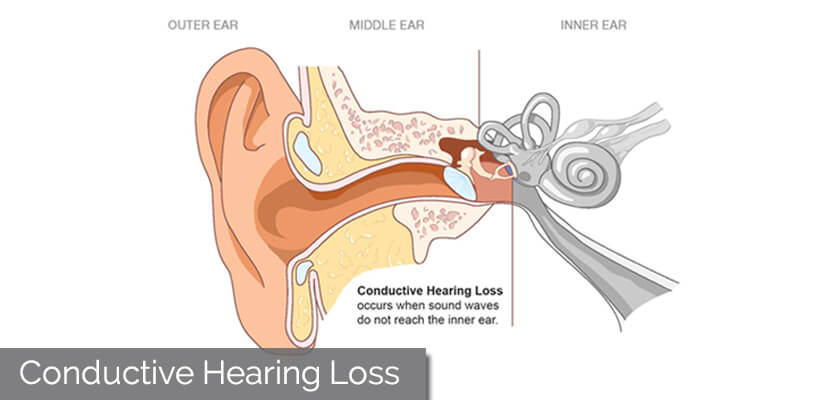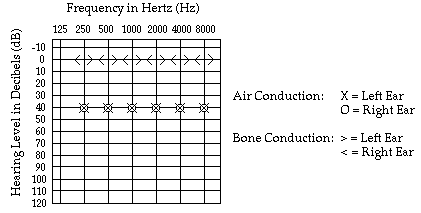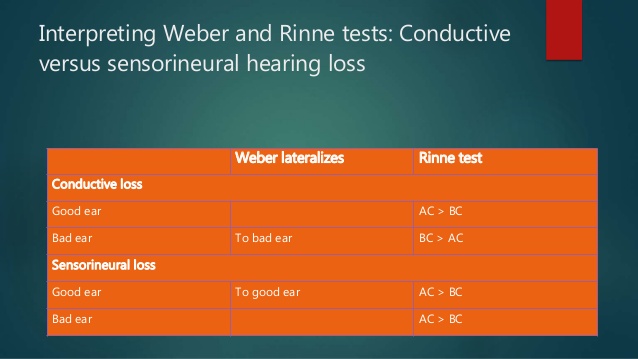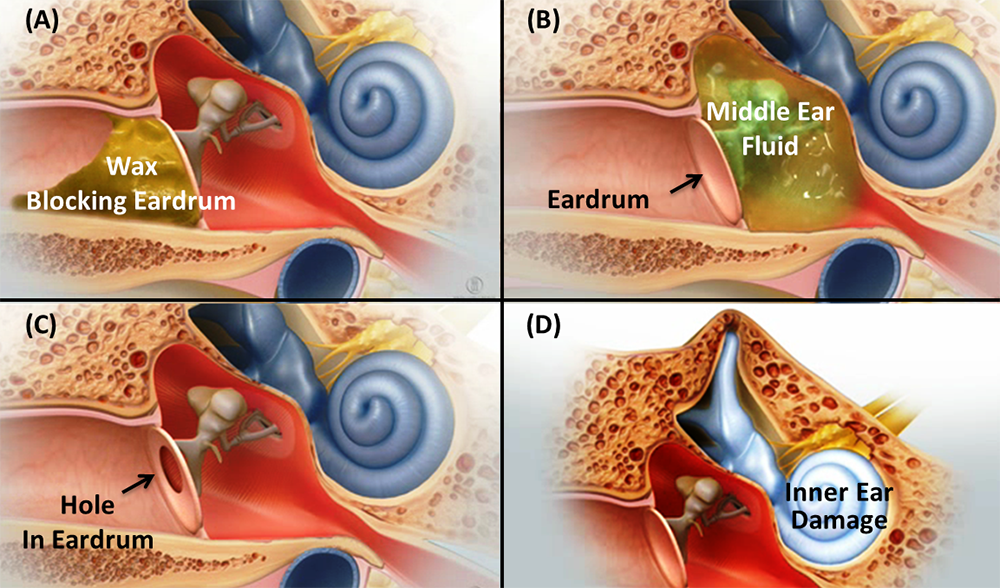
A conductive hearing loss is a type of hearing loss. It occurs when the ability of transmission of sound waves from outer or middle ear to inner ear is reduced or blocked. The blockage or damage is such that it prevents sound from getting passed into the inner ear (cochlea). In easier words, something is keeping sound from passing through the outer/middle ear to the inner ear and there is no problem in the inner ear. It may be unilateral or bilateral.
You can purchase the latest hearing aids at a fair price through HearingSol, If you need any assistance or you have a query regarding Hearing Aid or Hearing Loss, feel free to call us at +91-9327901950. We are always here to help you.
Conductive Hearing Loss Audiogram

Thus, even when the sound is loud enough, the individual hears it as soft or muffled. It is generally of a mild or moderate degree, ranging from 25 to 65 decibels. In some cases, a conductive hearing loss is temporary. It all depends on the specific cause of the problem (e.g. ear wax build-up). Therefore, it is important to know about conductive hearing loss and its causes.
Causes of Conductive Hearing Loss
When the sounds struggle to reach the eardrum from the outer ear, you may be suffering from conductive hearing loss. It is caused due to the various problems persisting in the specific part of an ear – outer, middle, and inner ear. Let’s have a look at these causes.
The problem in the middle ear
Fluid accumulation is the main reason for conductive hearing loss. It found especially in children. Fluid accumulation cause infection that blocks the Eustachian tube it also happens due to allergies or tumors.
- The coagulation of earwax in the outer ear causes blockage of the external ear canal.
- Infection in the ear canal.
- Otitis media or Middle ear infection
- Fluid in the ear.
- Tumors – Some time tumor block our outer or middle ear
- Abnormal growth or overgrowth of bones in the middle ear such as Otosclerosis.
- Hole in your eardrum or ruptured eardrum
- Birth defects or congenital injuries may lead to conductive hearing loss
- Injury to the outer ear
- Stiffening of the eardrum or middle ear bones
- Ear infections
- Blockage of the ear canal
- Malformation of the outer ear, ear canal, or middle ear structures.
- Cholesteatoma
- Eustachian Tube Dysfunction – Eustachian tube connects your middle ear and nose. Due to the improper functioning of this tube, the fluid stays in the middle ear and cause infections.
- Allergies
- Ear Barotrauma due to unequal pressure in the ear and outside the ear because of high altitude and change in pressure.
The problem in the external ear
The external ear is in direct contact with the external environment and ear wax is mixed with dust and clotting on an external ear that blocks the ear canal. It identified in medical examination and removed by cotton.
- Earwax or foreign body like cotton swab in the external auditory canal.
- Otitis externa: It happens in the swimmer’s ear as a result of an infection in the ear canal that may be related to water. Symptoms of otitis externa are irritation and pain swelling occurred in the ear canal.
- Exostoses: It is a formation of the external bone outer surface of an ear that narrowing the ear canal. It is managed by regular cleaning of ear wax to prevent obstruction.
- Atresia: Atresia is an abnormality in which the ear canal is completely closed, narrow or blocked. It is founded on breath and mostly on one side and is managed by surgical treatment. It is also known as congenital stenosis.
- Tumor of the ear canal – Tumors of the nerve that connects the brain usually grow slowly and never spread to anywhere of the brain; creating deafness in the affected ear.
- Acquired stenosis (narrowing) of the external auditory canal following surgery or radiotherapy.
A problem in the internal ear
- Superior canal dehiscence – which may require surgical correction.
- Widened vestibular aqueducts
Conductive Hearing Loss Symptoms
- Hearing difficulties in the speech like conversation seem to be whispering and muffling and in very low sounds.
- Unable to interpret and understand the speech in a normal voice.
- You will observe that your own sounds are different.
- Your one ear will seem better than the other.
- You may feel ear pain or pressure in both ears.
- Ear discharge in the form of pus, fluid can be felt.
- A strange odor from the ear.
- The person with conductive hearing loss can hear better after increasing the sounds of TV, radio, music systems, etc.
- It impacts the ability to perceive the sounds and noise appears to be faint than the usual.
Diagnosis of Conductive Hearing Loss
Otoscopy
Examination of the middle ear, tympanic membrane, or external ear through an otoscope. Audiologist observes the specific part of your by throwing light in order to identify the problem.
Differential Testing

Basic screening is done then it is followed by Rinne and Weber tests. Audiologists use a 256 Hz tuning fork to diagnose a conductive hearing loss in the Rinne test. A patient is asked to say whether a vibrating tuning fork is heard more loudly adjacent to the ear canal (air conduction) or touching the bone behind the ear (bone conduction), is negative indicating that bone conduction is more effective than air conduction.
In Weber’s test, a vibrating tuning fork is touched to the midline of the forehead, the person will hear the sound more loudly in the affected ear because background noise does not mask the hearing on this side.
- Weber Test – Sound localizes to affected ear (ear with the conductive loss)
- Rinne test – Negative Rinne; bone conduction > air conduction (bone/air gap)
Tympanometry
It is a simple objective test of the ability of the middle ear to transmit sound waves across it. This test is usually abnormal with conductive hearing loss.
Audiometry
Pure Tone Audiometry test is a standardized hearing test of 250 Hz to 8000 Hz. The shape of the plot reveals the degree or type of hearing loss whether it is conductive or sensorineural.
CT Scan
It is useful in cases of congenital conductive hearing loss, chronic suppurative otitis media or cholesteatoma, ossicular damage or discontinuity, otosclerosis. It diagnoses the anatomy of the ear.
How To Treat Conductive Hearing Loss?
It is temporary and removed by a medical treatment such as bone conduction hearing aids, Bone Anchored Hearing Devices, and Middle Ear Implants. In conductive hearing disorder, It may be hard to hear low-frequency sounds and high-frequency sounds may be heard.
- Conductive hearing loss need surgical, pharmaceutical as well as supportive treatment.
- The conditions like middle ear fluid, cholesteatoma, otosclerosis, head trauma need surgical treatment or repair.
- If hearing loss is due to infections and inflammation of the ear canal. Then, antibiotics or antifungal medications can help them.
- Severe or profound hearing loss will be treated by a middle ear implant or Cochlear implant.
- Hearing aids are a supportive means of treatment. Bone Conduction hearing aids will be helpful in this case.
You can purchase the latest hearing aids at a fair price through HearingSol, If you need any assistance or you have a query regarding Hearing Aid or Hearing Loss, feel free to call us at +91-9327901950. We are always here to help you.


